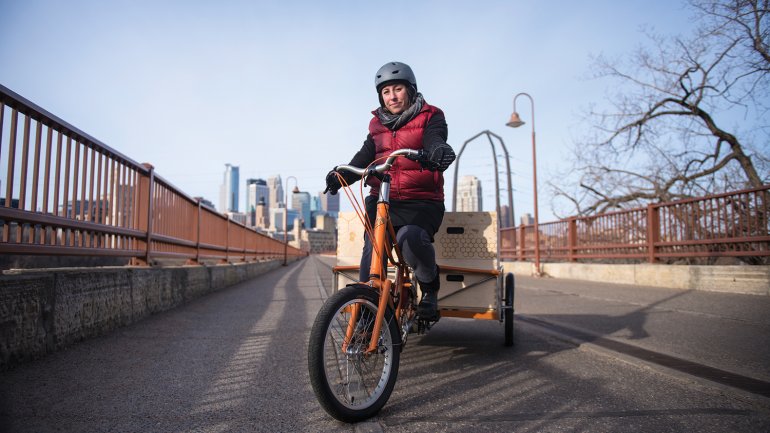Common Good
Common Good
The summer before she entered graduate school, Anna Metcalfe spent a month volunteering at Corrymeela, a center in Northern Ireland dedicated to fostering reconciliation between communities in strife. One day she took tea there with a group of single mothers, many of whom had husbands imprisoned during the region’s 30-year conflict known as the Troubles.
“I remember having a conversation with a Protestant mom and a Catholic mom, both of them rolling their cigarettes,” she recalls. It struck her that the two women shared a painful collective history of violent opposition – yet there they sat, chatting amiably. Amazing, she thought, the rapport that can happen over a simple cup of tea.
Today, as an artist whose practice centers on social engagement, Metcalfe looks back on that moment as both the genesis and quintessence of her purpose: to cultivate empathy. By using the warm and familiar medium of ceramics in collaborative public projects, she explores issues related to societal wellness – food, agriculture, ecology, community.
A onetime competitive swimmer, Metcalfe often focuses on bodies of water, such as Lake Superior or the Mississippi River running through Minneapolis, where she lives. She creates opportunities for people “to understand and be understood,” as she puts it. “Story – narrative – is the mechanism I’ve chosen to make that connection. The ceramic object is the conduit.”
“There is art at the service of art, and art at the service of life,” wrote Allan Kaprow, the visionary behind the 1950s and ’60s “happenings” that brought art into the realm of the public and the everyday, and one of Metcalfe’s inspirations. To design her own version of a happening, she’ll often first provide a prompt. She might ask lake dwellers to share memories and concerns about waterfront life or interview immigrants about a recipe that reminds them of home. Later, she may screenprint their words onto ceramic forms she makes for the occasion, such as cups, plates, or little canoes that actually float. Finally, she organizes an event that brings people and objects together – a tea party, a meal, a boat launch – where learning and fellowship can occur.
Though she sees her role as more facilitator and collaborator than artist, Metcalfe is interested in what she calls the aesthetics of engagement: “How can I get the most authentic version of the person I’m working with?” Being real and vulnerable herself, she finds, helps to elicit a response in kind. Because she works with many different kinds of people – teens, the elderly, people from various cultures and socioeconomic backgrounds – her approach continually evolves, the constant being “to honor their stories with appropriate integrity.”
Her own story began in the Virginia countryside. Born in 1978, she grew up near Shenandoah National Park, hiking and exploring in the woods, happiest outdoors. Her father was an airline pilot, while her mother served as a mentor and translator for children of migrant farm workers. Metcalfe loved to read and dreamed of writing and illustrating children’s books. Then, in high school, she took a ceramics class. “I remember so clearly the first time I sat at a wheel, thinking, ‘This is something I could do for the rest of my life.’ ”
After earning a degree in English from the College of William and Mary, she returned to rural Virginia to apprentice with potter Silvie Granatelli, then worked as a studio manager at La Meridiana, a ceramics school in Tuscany. “In Italy, food is such a big part of the way people experience joy,” says Metcalfe, who acquired a taste for seasonal eating and an appreciation for the depths of friendship that develop over long, convivial meals. In 2006, she enrolled in the MFA program at the University of Minnesota, where she helped create a community rain garden as part of a team led by Christine Baeumler, professor of interdisciplinary art and social practice. “That was the doorway that opened,” she says. “I could have object-making, social engagement, and an environmental impact. I was like, ‘This is what I want to do.’ ”
Since then, her art has entailed “a lot of meetings over coffee,” building relationships with groups, foundations, and agencies to bring her concepts to fruition. She does her solitary, contemplative work – transcribing interviews, making clay forms – in the bright sunroom she and her husband, composer Joshua Clausen, added onto their quirky, century-old farmhouse-style home. Her studio doors slide open to a big backyard, where she keeps chickens in partnership with a dozen or so friends – the Coop Co-op, they call themselves.
This summer, Metcalfe is hosting Pop-Up Pollinator Picnics in gardens and parks around the Twin Cities, where folks can learn about endangered bees while munching off her hexagonal, honeycomb-inspired plates. She sees the hive as a metaphor for community and the common good. “Queen, drone, workers – all these individual working parts are dependent upon their environment and each other for survival and well-being,” she says. “They have to sing together in some kind of harmony in order for it all to work.”

